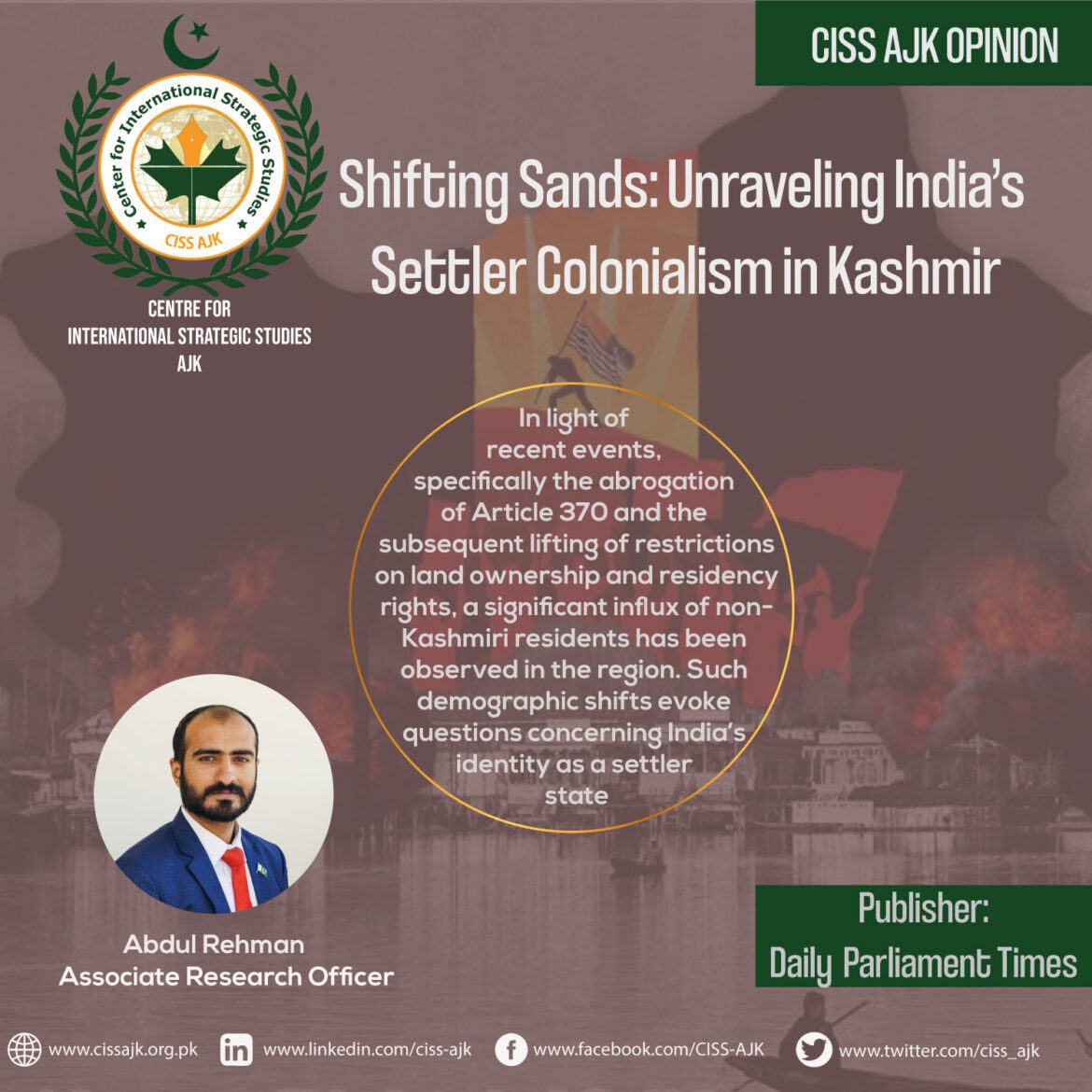686
August 5, 2019, marked a pivotal turning point in the protracted Kashmir dispute, prompting a reevaluation of the lens through which the region has traditionally been analyzed. While historical narratives have predominantly applied a colonial framework to comprehend the complexities of Kashmir, emerging developments have led scholars to consider an alternative perspective rooted in settler colonialism.
Colonialism and settler colonialism represent distinct yet interconnected modes of oppression, each characterized by migration and a hierarchical relationship. However, their fundamental objectives differ significantly. Classic colonialism operates as a “system of domination,” enabled by territorial expansion. In this context, colonizers aim to exploit the resources and labor of an indigenous majority to serve the interests of their distant metropolis. Conversely, settler colonialism pursues the permanent occupation of the colonized land. Settler states actively recruit settler classes who assert their alleged sovereign prerogative to establish a new state on the indigenous population’s land. To maintain their dominion, settler states, often assisted by a local administration, construct narratives of distinctive cultural identity, establish independent systems of law and order, and rely on military and economic power.
In light of recent events, specifically the abrogation of Article 370 and the subsequent lifting of restrictions on land ownership and residency rights, a significant influx of non-Kashmiri residents has been observed in the region. Such demographic shifts evoke questions concerning India’s identity as a settler state, as the arrival of new settlers potentially alters the social fabric and marginalizes the indigenous populace, thus accentuating the relevance of the settler colonial lens in comprehending the complexities of the Kashmir issue. The subsequent removal of restrictions on land ownership and residency rights has raised fears of demographic change in the region. Critics contend that the lifting of these restrictions has opened the floodgates for non-Kashmiri settlers to move in, thereby altering the demographics and potentially eroding the indigenous culture that has thrived for centuries.The settler colonial agenda has materialized through large-scale land acquisitions for various development projects in Jammu and Kashmir. Many of these projects, including infrastructure and tourism initiatives, have been conducted without meaningful consultation with local communities, leading to the displacement of indigenous people from their ancestral lands. Peoples Democratic Party (PDP) President and former chief minister Mehbooba Mufti accused the J&K administration of “bringing the people from outside under the garb of land for landless and home for the homeless to change the region’s demography”. According to a news gathering agency Kashmir News Observer (KNO), addressing a press conference at PDP headquarters in Srinagar, Mehbooba said that after the abrogation of Article 370, the administration considers the jobs, water resources, and land of the people of J&K as “war booty”. The prolonged and often heavy-handed presence of armed forces in Jammu and Kashmir is justified by the Armed Forces Special Powers Act (AFSPA).
However, this legislation has been widely criticized for providing security forces with impunity in areas labeled as “disturbed.” As a result, numerous reports of human rights abuses have emerged, including allegations of extrajudicial killings, enforced disappearances, and sexual violence against Kashmiri civilians. According to Human Rights Watch 2020 report “The Armed Forces (Special Powers) Act continued to provide effective immunity from prosecution to security forces, even for serious human rights abuses.The influx of non-indigenous settlers and policies that favor their integration can lead to the dilution of Kashmiri identity, language, and traditions. Moreover, the promotion of non-indigenous cultural expressions may overshadow and marginalize the rich and diverse cultural heritage of the Kashmiri people.The lopsided emphasis on Kashmir’s Hindu heritage has supplied non-Kashmiri Hindus with both the reason to desire the region and the justifications to do so. In particular, the promotion of the Amarnath Yatra — a Hindu pilgrimage to an ice formation believed to represent Lord Shiva— has grown increasingly over the years through increased institutional support. By bringing Hindu temples and relics to the fore, the Indian state and its proponents have only fueled the idea that it is Muslim Kashmiris who are the exogenous “Others”. The settler colonial agenda can exacerbate economic disparities between settlers and the indigenous population. Non-Kashmiri settlers may have access to better economic opportunities and resources, facilitated by the state’s policies, while the local population faces systemic barriers and discrimination. This unequal distribution of resources can further deepen the economic marginalization of the indigenous people, reinforcing their sense of injustice and exclusion from mainstream society.The settler colonial agenda of India in Jammu and Kashmir has significant implications for the region’s future stability, human rights, and socio-cultural fabric. Demographic changes, land acquisitions, human rights abuses, erosion of cultural identity, economic disparities, and political marginalization have created an environment of tension and unrest. To achieve lasting peace and justice in the region, it is crucial for the international community and policymakers to closely monitor the situation, ensure respect for human rights, and engage in meaningful dialogue with all stakeholders involved.



